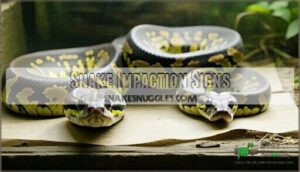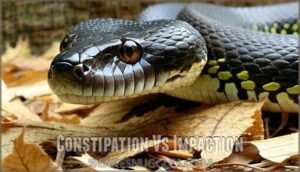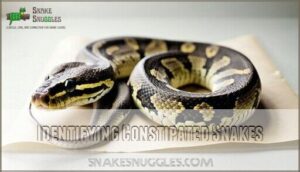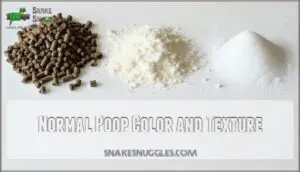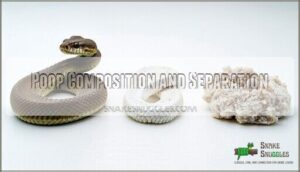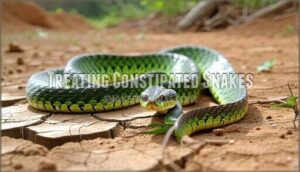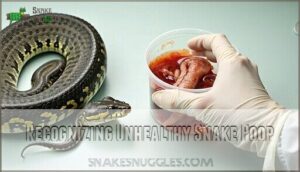This site is supported by our readers. We may earn a commission, at no cost to you, if you purchase through links.
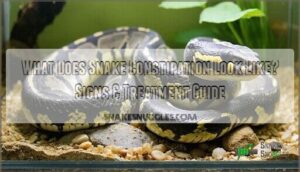
You’ll notice they haven’t produced waste in longer than their normal pattern – this varies by species and feeding schedule, but most snakes defecate within 5-10 days after eating.
Constipated snakes often become lethargic, moving less than usual, and may refuse their next meal even when it’s feeding time.
Their body might feel firmer to the touch, and you could spot them straining or making unusual movements near their vent area.
The underlying causes and treatment options reveal some surprising details about snake digestive health.
Table Of Contents
- Key Takeaways
- Snake Constipation Overview
- What Does Constipation Look Like
- Snake Impaction Signs
- Constipation Vs Impaction
- Identifying Constipated Snakes
- Snake Poop Characteristics
- Health Risks of Constipation
- Treating Constipated Snakes
- Preventing Constipation in Snakes
- Recognizing Unhealthy Snake Poop
- Frequently Asked Questions (FAQs)
- How do you know if a snake is constipated?
- What does snake poop look like?
- What does corn snake poop look like?
- What does it mean if you see snake poop?
- What is the difference between Snake poop and reptile poop?
- What does snake poop contain?
- What does snake impaction look like?
- What does an unhealthy snake poop look like?
- How do I help my snake poop?
- How long can snakes go without pooping normally?
- Conclusion
Key Takeaways
- Watch for visible bloating – Your snake’s belly will appear swollen or distended, especially in the lower third of their body, and may feel firmer than usual when gently touched.
- Track their bathroom schedule – If your snake hasn’t pooped within 5-10 days after eating (or longer than their normal pattern), they’re likely constipated and need attention.
- Notice behavioral changes – You’ll see lethargy, reduced movement, loss of appetite, and possible straining or unusual positioning near their vent area.
- Don’t wait too long – Early intervention with warm water soaks, proper humidity, and temperature regulation can prevent serious impaction that requires emergency vet care.
Snake Constipation Overview
Snake constipation isn’t always obvious, but you’ll notice key warning signs when your pet struggles with digestive issues.
Understanding these symptoms helps you act quickly before minor constipation becomes a serious health emergency requiring veterinary intervention.
Symptoms of Constipation
When your snake’s struggling with constipation, you’ll notice these telltale signs. Watch for these key symptoms:
Your snake’s body language speaks louder than words when constipation strikes.
- Regurgitation signs and vomiting episodes that seem unusual
- Tenesmus presence – that uncomfortable straining without results
- Palpable impactions you can actually feel along their body
Dyspnea causes breathing difficulties when distended bowel loops press against organs.
Appetite loss pairs with lethargy as your constipated snake becomes increasingly uncomfortable. If your snake not pooping continues beyond two weeks after eating, these constipated snake symptoms signal it’s time for intervention.
Causes of Constipation
Understanding what triggers snake constipation helps you prevent this uncomfortable condition.
Several environmental and dietary factors contribute to digestive issues in your pet snake.
| Environmental Causes | Dietary Causes | Physical Causes |
|---|---|---|
| Low Humidity levels | Oversized prey items | Dehydration Risks |
| Improper Temperatures | Poor Diet quality | Inadequate exercise |
| Inadequate water access | Infrequent feeding | Impaction from substrate |
| Stress Factors | Frozen prey issues | Age-related slowdown |
| Poor enclosure setup | Nutritional imbalances | Underlying illness |
Dehydration remains the primary culprit behind reptile constipation causes, while prey size directly affects your snake’s ability to process meals efficiently.
Constipation can also arise from inadequate enclosure size, limiting the snake’s ability to move and properly digest its food.
Risk Factors for Constipation
Several environmental factors can put your snake at risk for reptile digestive issues.
Poor temperature gradient prevents proper digestion, while inadequate enclosure humidity leads to dehydration.
Oversized prey size strains the digestive system, and insufficient hydration levels compound the problem.
Underlying illnesses weaken digestive function, making snake constipation more likely when these environmental factors aren’t properly managed, particularly due to inadequate enclosure humidity.
What Does Constipation Look Like
When your snake’s having trouble with their bowel movement, you’ll notice several telltale signs that something’s not quite right.
Straining during attempts to defecate is often the first red flag – your snake may spend extended periods in their usual elimination spots without producing results.
You might observe them passing mucus without any solid waste, which indicates their body’s trying to lubricate the passage for dry feces that won’t budge.
Infrequent defecation becomes obvious when weeks pass without normal snake poop characteristics appearing in their enclosure.
Their typical schedule gets thrown off completely.
Visible discomfort shows through restless behavior, unusual positioning, or apparent abdominal tension.
Hard stools, when they finally appear, look drastically different from healthy waste – they’re often small, pellet-like, and lacking the normal moisture content.
Dry stool indicates dehydration issues affecting their digestive system.
These snake poop abnormalities signal your pet needs immediate attention before the situation worsens into serious impaction.
Snake Impaction Signs
When your snake progresses from simple constipation to impaction, you’ll notice more severe warning signs that demand immediate attention.
Impacted snakes often show visible abdominal swelling, complete loss of appetite for weeks, and may even experience difficulty breathing as hardened fecal masses press against internal organs, which can be a sign of complete loss of normal bodily functions.
Fecal Impaction Symptoms
When impaction reaches severe levels, you’ll notice palpable impactions as hard masses you can feel through your snake’s body wall.
Distended bowels create visible swelling that may cause breathing difficulties as enlarged intestinal loops press against the lungs.
Reduced mobility becomes apparent as your snake struggles to move normally, sometimes showing partial paralysis in affected areas.
Foreign obstruction from inappropriate prey items can block the digestive tract completely.
These severe symptoms of fecal impaction often require surgical solutions when conservative treatments fail to resolve the snake constipation.
Digital Disimpaction Method
When standard treatments fail, a reptile vet may perform digital disimpaction for severe snake impaction treatment.
This snake health problems solution involves using gloved fingers with proper lubrication importance to manually remove hardened fecal masses.
Glove safety prevents contamination while careful force application breaks up fecal hardness without tissue damage.
Dehydration is a primary factor, often leading to urate plugs forming.
Treating snake constipation through this method requires veterinary expertise, followed by essential post-procedure care monitoring to ensure the snake’s health is properly managed and to prevent future snake impaction issues.
Enema Treatment Option
When manual removal isn’t effective, your reptile vet might recommend enema solutions as the next step in treating snake constipation. This veterinary treatment involves carefully administered fluids to help flush out impacted material and restore normal bowel function.
A common cause of constipation in reptiles is inadequate enclosure temperature.
- Warm saline or mineral oil mixtures are common enema solutions used by veterinarians
- Professional administration techniques guarantee safe catheter insertion and proper fluid delivery
- Post-enema care includes monitoring for complications and continued hydration support
Potential risks include tissue damage from improper technique, making professional veterinary treatment essential. Enema alternatives like increased soaking and dietary adjustments should be tried first before considering this snake impaction treatment option.
Constipation Vs Impaction
You’ll need to understand the key differences between constipation and impaction to properly care for your snake.
While impaction is a more serious condition where hardened waste becomes completely stuck and requires immediate intervention, constipation involves difficulty passing stool.
Definition of Constipation
When you notice your snake struggling with stool passage difficulty, you’re likely dealing with constipation.
This condition involves reduced frequency of bowel movements, causing abdominal discomfort from hardened feces.
Snake constipation creates incomplete evacuation, leaving your reptile uncomfortable and requiring constipation relief interventions.
| Aspect | Normal State | Constipated State |
|---|---|---|
| Frequency | Every 6-8 days | 2+ weeks without bowel movement |
| Stool Texture | Firm but pliable | Hard, dry, difficult to pass |
| Snake Behavior | Active, normal appetite | Lethargic, reduced eating |
Definition of Impaction
Understanding fecal impaction helps you recognize when your snake’s digestive troubles become serious.
Impaction occurs when hardened waste creates complete blockages in your snake’s intestinal tract, preventing natural elimination.
| Impaction Aspect | Description |
|---|---|
| Fecal Buildup | Large, dry masses stuck in rectum |
| Blockage Severity | Complete obstruction requiring intervention |
| Foreign Obstruction | Inappropriate items blocking digestive tract |
| Reduced Mobility | Paralysis depending on blockage location |
Differences Between Constipation and Impaction
Constipation severity differs substantially from impaction consequences.
While constipation means difficulty passing stool, impaction creates complete blockages requiring immediate intervention methods.
Chronic constipation can progress to fecal impaction without preventative measures.
| Aspect | Constipation | Impaction |
|---|---|---|
| Definition | Difficulty passing stool | Complete blockage of hardened feces |
| Severity | Mild to moderate discomfort | Medical emergency requiring intervention |
| Treatment | Warm soaks, humidity adjustments | Veterinary care, possible surgery |
| Timeline | Days to weeks development | Immediate serious condition |
| Prevention | Regular hydration, proper diet | Early constipation treatment |
Identifying Constipated Snakes
You’ll notice several clear warning signs when your snake is constipated that require immediate attention.
The most obvious indicators include lack of bowel movements for over two weeks after eating, complete loss of appetite, and visible bloating accompanied by unusual lethargy, which can be summarized as a complete loss of normal behavior.
Lack of Bowel Movement
Your snake’s defecation frequency reveals critical health information.
Healthy snakes typically produce snake poop within 6-8 days after eating.
If there’s no snake bowel movement for two weeks post-feeding, this signals potential reptile constipation relief needs.
Monitor stool consistency and hydration levels closely.
Anorexia signs often accompany bowel irregularities, affecting your snake’s digestive system.
Consider veterinary consultation when normal patterns change substantially.
Loss of Appetite
Anyone dealing with a constipated snake will notice their pet’s eating habits change dramatically. Loss of appetite often accompanies digestive blockages, creating a concerning cycle where Hunger Strikes worsen snake constipation.
When your snake refuses food, it’s signaling something’s wrong with their system.
- Your snake turns away from their favorite prey items
- Feeding becomes a battle of wills and worry
- Days stretch into weeks without normal eating patterns
Understanding Appetite Causes helps identify whether you’re facing simple Refusal Reasons or serious impaction.
While some owners consider Force Feeding, proper Feeding Strategies focus on addressing the underlying digestive issue first.
Snake feeding issues often resolve once the constipation clears.
Bloating and Lethargy
Beyond appetite loss, you’ll notice visible bloating around your snake’s midsection – a telltale swollen abdomen that signals digestive discomfort.
This physical distension often accompanies pronounced lethargy, where your normally active snake becomes sluggish and less responsive.
Energy depletion manifests as reduced activity levels, with your pet spending excessive time motionless, indicating serious internal issues requiring immediate attention before snake constipation progresses further.
Snake Poop Characteristics
Understanding what normal snake poop looks like helps you spot constipation early and take action before it becomes serious.
When you know the difference between healthy waste and problem signs, you can keep your snake comfortable and avoid costly vet visits.
Normal Poop Color and Texture
Healthy snake feces appear dark brown to black with a firm, Play-Doh-like consistency.
You’ll notice three distinct parts: the main waste, chalky white urates, and clear urine.
Normal poop texture feels solid but not rock-hard, while proper waste separation shows clear divisions between components.
Small prey remnants like bones or fur are perfectly normal in snake poop appearance.
Regular observation helps establish a baseline for snake health and detect changes early, following the guidelines at baseline for snake health, which is crucial for healthy snake care and understanding snake poop appearance and proper waste management.
Abnormal Poop Characteristics
When constipation strikes, you’ll notice distinct changes in your snake’s waste that signal trouble.
Abnormal Color and Unusual Odor become telltale signs something’s wrong with your pet’s digestive system.
Watch for these concerning snake poop abnormalities:
- Undigested Food pieces visible throughout the waste, indicating incomplete digestion
- Presence Blood or red streaks mixed within the feces, suggesting internal irritation
- Excessive Mucus coating that makes snake poop consistency slimy and unhealthy snake poop appearance drastically different from normal
Poop Composition and Separation
Normal snake poop contains three distinct components that tell you about your pet’s health.
The brown fecal matter should separate clearly from white, chalky urates—think of it like a two-toned ice cream cone.
When constipation strikes, this normal separation breaks down completely.
| Normal Components | Constipation Signs |
|---|---|
| Brown feces with white urates cap | Hard, dry masses without separation |
| Firm Play-Doh consistency | Rock-hard, difficult to pass |
| Clear separation between parts | Mixed, unseparated waste |
| Mild earthy odor | Strong, foul smell |
Watch for abnormal separation or missing urates—these digestion indicators signal trouble brewing in your snake’s system.
Health Risks of Constipation
When your snake becomes constipated, you’re not just dealing with a simple digestive issue—serious health complications can develop rapidly.
Constipation creates a dangerous cycle where dehydration worsens the blockage while bacterial infections and parasites multiply in the stagnant waste, potentially leading to life-threatening sepsis.
Dehydration and Low Humidity
Poor water availability creates the perfect storm for snake constipation.
When humidity levels drop below species requirements, your snake’s body struggles with proper digestion and waste elimination.
Environmental control becomes critical since dehydration affects every bodily function, including bowel movements.
Here are key dehydration risks:
- Drinking behavior changes – Snakes drink less when stressed or uncomfortable
- Shedding difficulties – Low humidity causes incomplete sheds, creating additional stress
- Snake temperature requirements – Improper temps worsen dehydration effects
- Snake husbandry failures – Poor environmental monitoring leads to chronic issues
Large Meals and Inadequate Hydration
Everything affects digestion when you’re dealing with oversized meals and inadequate hydration.
Large prey size strains your snake’s digestive system, while poor water availability compounds the problem.
When humidity levels drop, snake constipation becomes more likely as dehydration sets in.
Your snake’s body struggles to process massive meals without proper hydration, creating perfect conditions for impacted snake poop and compromised snake digestion throughout the process.
Maintaining proper temperatures helps avoid low temperature effects, which is crucial for preventing snake constipation and ensuring proper hydration and digestive system function.
Bacterial and Parasite Risks
Dealing with constipated snakes means facing potential bacterial diseases and snake parasites that threaten both your pet’s health and yours.
E. coli and Salmonella dangers lurk in backed-up waste, while worm infestations multiply in stagnant digestive systems.
These snake health risks create respiratory issues when dried feces become airborne, plus allergen exposure affects sensitive individuals.
Treating Constipated Snakes
When you notice signs of constipation in your snake, prompt treatment can prevent the condition from progressing to dangerous impaction.
You have several effective options ranging from simple home remedies like warm water soaks to professional veterinary interventions when the situation becomes severe.
Soaking in Warm Water
Soaking your constipated snake in warm water for 15 minutes helps soften hardened feces and stimulates bowel movements.
Water temperature should remain between 78-85°F to guarantee species sensitivity isn’t compromised.
This gentle reptile constipation relief method works by hydrating the snake’s system and relaxing muscles. Maintaining the correct water temperature is vital for the snake’s comfort.
Monitor soak duration carefully, as extended exposure can stress your pet. Post-soak care involves gently drying your snake before returning it to its enclosure.
Increasing Humidity and Offering Smaller Prey
Beyond soaking, you’ll want to boost your enclosure’s humidity levels and adjust feeding practices.
Higher humidity helps soften stool naturally, while smaller prey reduces digestive strain on your snake’s system.
Here are three key approaches for humidity benefits and prey size management:
- Increase enclosure humidity to 60-80% using larger water bowls, damp substrate, or humidifiers to improve digestion and prevent future constipation episodes.
- Switch to smaller prey items that are easier to digest – choose prey that’s 10-15% of your snake’s body weight rather than maximum-sized meals.
- Implement preventative measures by maintaining consistent humidity year-round and establishing a regular feeding schedule with appropriately-sized prey for long-term health.
These adjustments support your snake’s digestive system while addressing the root causes of snake constipation, creating better conditions for natural waste elimination.
Veterinary Intervention and Surgery
When conservative treatments fail, you’ll need veterinary care from an experienced reptile veterinarian.
Severe cases become a medical emergency requiring Advanced Diagnostics like radiographs.
Surgical Options include enterotomy under anesthesia, though Anesthesia Risks exist.
Enema Procedures may be attempted first.
Surgery involves removing impacted material, followed by strict Post-Op Care including fasting and antibiotic therapy for ideal recovery.
Preventing Constipation in Snakes
Prevention starts with maintaining proper environmental conditions and feeding practices.
You’ll want to make certain adequate temperature gradients, consistent humidity levels, and appropriately sized prey to keep your snake’s digestive system functioning smoothly, which involves proper maintenance of these conditions to ensure the snake’s health.
Proper Temperature Regulation
Temperature regulation is your snake’s digestive powerhouse.
You’ll need proper heating gradients with basking spots reaching 88-92°F and night temperatures dropping 10-15°F.
Thermostat accuracy matters—inconsistent temps slow digestion and cause snake constipation.
Temperature monitoring prevents impaction by keeping your snake’s digestive system running smoothly.
Cold snakes can’t process snake poop effectively, leading to serious blockages, and it’s crucial for preventing impaction.
Balanced Diet and Hydration
Proper nutrition and adequate water intake work hand in hand to keep your snake’s digestive system running smoothly.
A well-balanced diet prevents the hard, compacted snake poop that signals trouble ahead.
Here are five dietary essentials for healthy digestion:
- Prey Size – Feed items no wider than your snake’s thickest body part to facilitate easy passage through the digestive tract
- Feeding Schedule – Maintain consistent intervals between meals, typically every 7-14 days for adult snakes depending on species
- Water Intake – Provide fresh water constantly and make certain your snake can fully submerge for proper hydration
- Supplementation – Avoid unnecessary vitamins that can disrupt natural digestion processes in captive snakes
- Diet Variety – Rotate appropriate prey types to provide balanced nutrition and prevent dietary deficiencies that affect snake care
Regular Monitoring and Maintenance
Consistent Habitat Upkeep guarantees your snake’s digestive health stays on track.
Monitor these key areas weekly to prevent snake constipation before it becomes problematic.
| Monitoring Area | Frequency | What to Check |
|---|---|---|
| Weight Monitoring | Weekly | Body condition, visible ribs, healthy curves |
| Hydration Practices | Daily | Fresh water, humidity levels 50-60% |
| Snake Poop | After feeding | Normal texture, color, urate presence |
| Shedding Assistance | Monthly | Complete sheds, stuck pieces, humidity |
| Handling Frequency | Limited | Stress levels, feeding schedule impacts |
Regular snake care prevents most digestive issues through consistent observation and maintenance routines.
Recognizing Unhealthy Snake Poop
You’ll know your snake’s struggling with constipation when its poop shows telltale warning signs that signal digestive distress.
Abnormal coloration, blood streaks, excessive mucus, or unusually foul odors can indicate your pet needs immediate attention before the situation worsens.
Abnormal Color and Texture
While prevention keeps your snake healthy, recognizing abnormal snake poop color and texture helps you catch digestive issues early.
Healthy snake poop consistency should resemble firm Play-Doh, but digestive issues can dramatically alter poop appearance.
Watch for these warning signs in your snake’s waste:
- Green or yellow coloring – indicates poor digestion or dietary impact from inappropriate prey
- Rock-hard texture – suggests severe dehydration and compromised hydration levels
- Watery consistency – points to potential parasites or illness affecting normal poop consistency
- Unusual components like excessive undigested food pieces signal processing problems
- Chalky white throughout instead of just the urate cap shows abnormal poop patterns.
Monitoring healthy snake poop helps establish a health baseline.
Presence of Blood or Mucus
When blood or mucus appears in your snake’s poop, it’s waving red flags about serious health issues.
Hematochezia causes range from parasite indicators like intestinal worms to internal bleeding from constipation-related trauma.
Mucus significance increases when it’s excessive or discolored, signaling gut inflammation.
Snake poop color changes alongside these symptoms often reflect dietary influence or underlying disease requiring immediate veterinary attention.
Foul Odor and Loose Composition
When unhealthy snake poop hits your nose, you’ll know something’s wrong.
Normal snake waste shouldn’t assault your senses like rotten eggs or sewage.
Strong, foul odors often signal bacterial overgrowth or digestive issues within your snake’s system.
Meanwhile, loose composition changes transform typical firm snake poop characteristics into watery messes.
Environmental factors like poor husbandry can trigger these concerning snake poop appearance shifts, indicating your snake’s digestive system needs attention before snake constipation worsens, which may be caused by digestive issues.
Frequently Asked Questions (FAQs)
How do you know if a snake is constipated?
Something’s not right when your snake hasn’t defecated for two weeks after eating.
You’ll notice bloating, lethargy, loss of appetite, and possible vomiting.
The belly may feel firm with palpable masses.
What does snake poop look like?
Snake poop appears as dark brown to black tubular droppings topped with a chalky white urea cap.
You’ll notice it’s smooth, oblong-shaped, and may contain undigested bits like fur or bones from prey.
What does corn snake poop look like?
Regarding the straight dope, your corn snake’s poop typically appears as a tubular, dark brown mass topped with a white chalky urate cap, resembling bird droppings with undigested prey remnants.
What does it mean if you see snake poop?
Finding snake poop typically means you’ve discovered evidence of a snake’s presence in that area.
It indicates the snake has been feeding and digesting prey there recently, though the snake itself has likely moved on.
What is the difference between Snake poop and reptile poop?
Notably, there’s virtually no difference between snake poop and reptile poop since snakes ARE reptiles.
You’ll find the same tri-colored composition—dark brown feces, white chalky urates, and clear urine—across most reptile species, making identification tricky without additional context clues, as reptile species share similar characteristics, and the presence of tri-colored composition is a key factor.
What does snake poop contain?
You’ll find snake poop contains brown-to-black feces, white chalky urates, and clear urine. It often includes undigested prey remnants like bones, fur, feathers, or scales, reflecting what they’ve eaten recently.
What does snake impaction look like?
Snake "digestive distress" manifests as visible bloating, lethargy, and loss of appetite.
You’ll notice your snake hasn’t defecated for weeks despite eating, may vomit, and feel firm masses when gently palpating their belly area, which can indicate digestive distress.
What does an unhealthy snake poop look like?
Unhealthy snake poop shows red streaks, yellow discoloration, strong foul odors, or visible undigested food pieces. You’ll notice rock-hard consistency, watery diarrhea, or missing white urate caps signaling digestive issues.
How do I help my snake poop?
Try soaking your snake in warm water for 15 minutes to soften things up.
You can also gently massage their belly or increase humidity levels in their enclosure to help things move along naturally.
How long can snakes go without pooping normally?
Wondering when to worry? Most healthy snakes defecate within 6-8 days after eating. If two weeks pass without a bowel movement, your snake needs help passing waste.
Conclusion
Knowledge is power, and recognizing what does snake constipation look like empowers you to act quickly when your reptile needs help.
Watch for bloating, extended periods without defecation, lethargy, and appetite loss as key warning signs.
Early intervention through proper humidity, temperature regulation, and warm water soaks can prevent serious complications.
However, don’t hesitate to consult an exotic veterinarian if symptoms persist or worsen, as severe cases may require professional treatment to guarantee your snake’s health and comfort.

